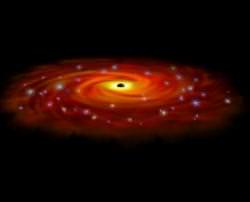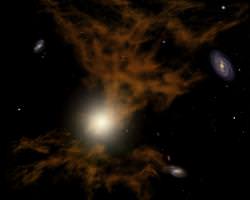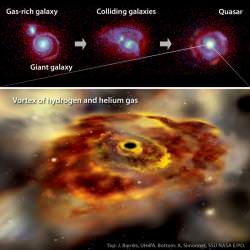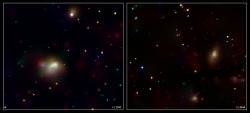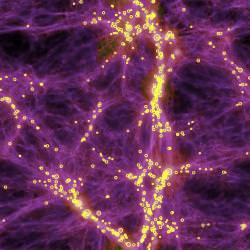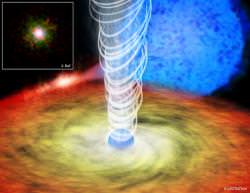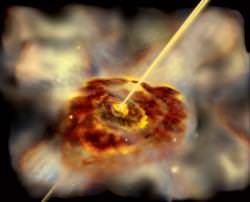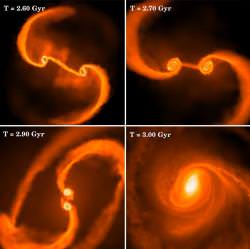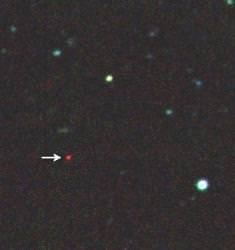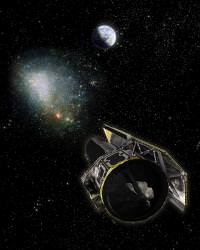Astronomers now believe there’s a supermassive black hole at the centre of almost every galaxy in the Universe. These black holes can have millions, or even hundreds of millions of times the mass of the Sun. Unlike stellar mass black holes, the supermassive versions might have formed differently, going from a cloud of gas directly to a black hole – skipping the star stage entirely.
Since their discovery, astronomers still don’t really know how supermassive black holes got going. But there they are, inside most galaxies. In fact, quasar observations show that supermassive black holes were present in the early Universe. Quasars are some of the brightest objects in the Universe, blazing from the radiation emitted by supermassive black holes actively consuming material.
One possibility is that these monsters had humble beginnings, starting out as a massive star, going supernova, and then becoming a black hole. It’s a process astronomers understand fairly well. The problem with this theory is that these early supermassive black holes must have been growing constantly right from the beginning, at the maximum rate predicted by physics. And as we see today, galaxies go through active and quiescent stages depending on when their black hole is consuming material.
But a second possibility is that these black holes formed directly, pulling together so much material that they bypassed the stellar stage entirely.
Dr. Mitchell C. Begelman, a professor in the Department of Astrophysical and Planetary Sciences at the University of Colorado, Boulder recently published a paper entitled Did supermassive black holes form by direct collapse? This paper sketches out this alternate theory of black hole formation in the early Universe.
After the Big Bang, the Universe cooled enough for the first stars to form out of the original hydrogen and helium. This was pure material, unpolluted by previous generations of stars. Astronomers have calculated that these first stars, called Population III, would have a maximum rate that they could gather material together to form a star.
But what if there was much more gas around? Way beyond the limits that could form a star.
With a regular star, material comes in relatively slowly, creating a central mass. With enough mass, the star ignites, and this creates and outward pressure that stops further material from compacting too tightly.
But Dr. Begelman has calculated that if the infall rate exceeds just a few tenths of a solar mass per year, the stellar core would be so tightly bound that the energy release of nuclear fusion wouldn’t be enough to stop the core from continuing to contract. You would never have a star, you would just go from a cloud of hydrogen to a tightly bound central mass. And then a black hole.
The question is, would it be possible to have material come together so quickly? It can, if something’s pushing it… like dark matter. According to Dr. Begelman, there could be several situations where an external force, like the gravity from a large halo of dark matter which could work to force gas into a central area. In fact, material has been calculated falling into a black hole this quickly, because that’s the rate it takes to power quasars. But the question is, will this work if the black hole isn’t there, or really small.
Once there are a few solar masses of accumulated gas, the core begins to shrink under the pull of its increasing mass. The object goes through a brief period of nuclear fusion when it reaches 100 solar masses, but it passes through this phase so rapidly that it doesn’t get a chance to expand again.
Eventually the object reaches several thousand solar masses, and its temperature has climbed to several hundred million degrees. At this point, gravity finally takes over, collapsing the core, and turning the object into a 10-20 solar mass black hole which then starts consuming all the mass around it.
From this point on, the black hole is able to draw in further material efficiently, growing at the maximum levels predicted by physics, eventually gathering up millions of times the mass of the Sun. If too much material falls in, the baby supermassive black hole might act like a mini-quasar – Dr. Begelman has dubbed this a “quasistar” – blazing with radiation as infalling material backs up in the black hole’s surroundings.
And there’s the good news: these quasistars might be detectable by powerful telescopes. However, they would have very short lifetimes, only lasting 100,000 years. They might be marginally detectable by the upcoming James Webb Space Telescope.
Original Source: Arxiv paper

